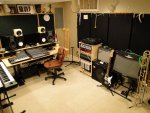hi,
i'm in the process of setting up a recording studio and have come to the tricky issue of acoustics...
From what I've read, it's best to set up absorption pads at several mirror points behind the monitors, on the left and right walls of monitors, on the ceiling, on the rear wall.....no one seems to mention what to do about the floor??? is it better to have a wooden floor with no absorption or to put an absorption pad down at the 'mirror' point below the monitor speakers?
Additionally, is no studio desk better than a studio desk....was thinking of just getting Roland SS-PC1 Laptop Support Stand to minimise early reflections thus avoiding the need for studio desk...
any help would be much appreciated!
i'm in the process of setting up a recording studio and have come to the tricky issue of acoustics...
From what I've read, it's best to set up absorption pads at several mirror points behind the monitors, on the left and right walls of monitors, on the ceiling, on the rear wall.....no one seems to mention what to do about the floor??? is it better to have a wooden floor with no absorption or to put an absorption pad down at the 'mirror' point below the monitor speakers?
Additionally, is no studio desk better than a studio desk....was thinking of just getting Roland SS-PC1 Laptop Support Stand to minimise early reflections thus avoiding the need for studio desk...
any help would be much appreciated!

